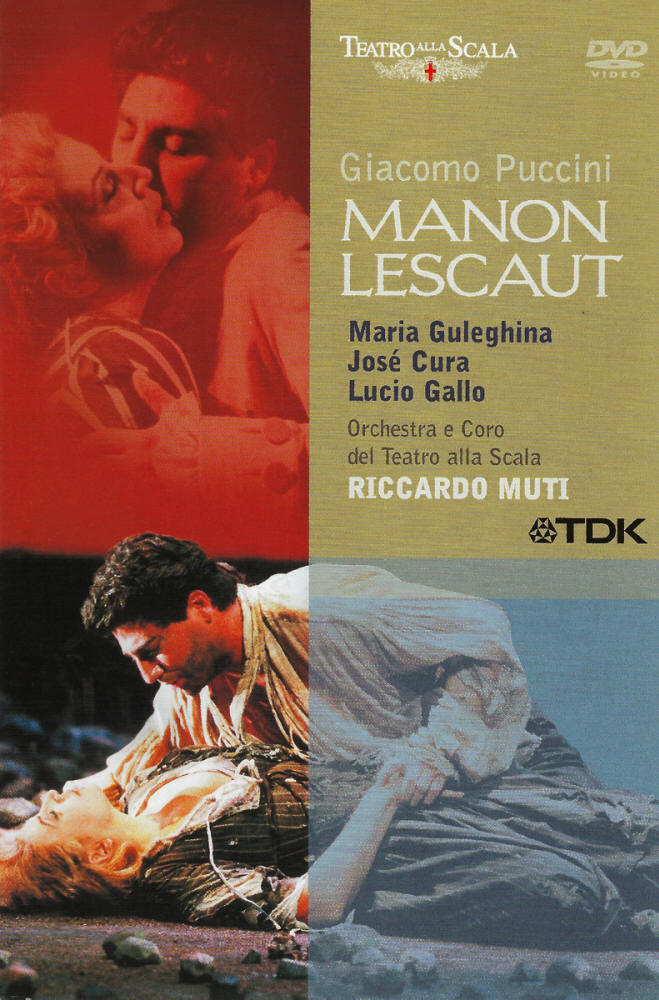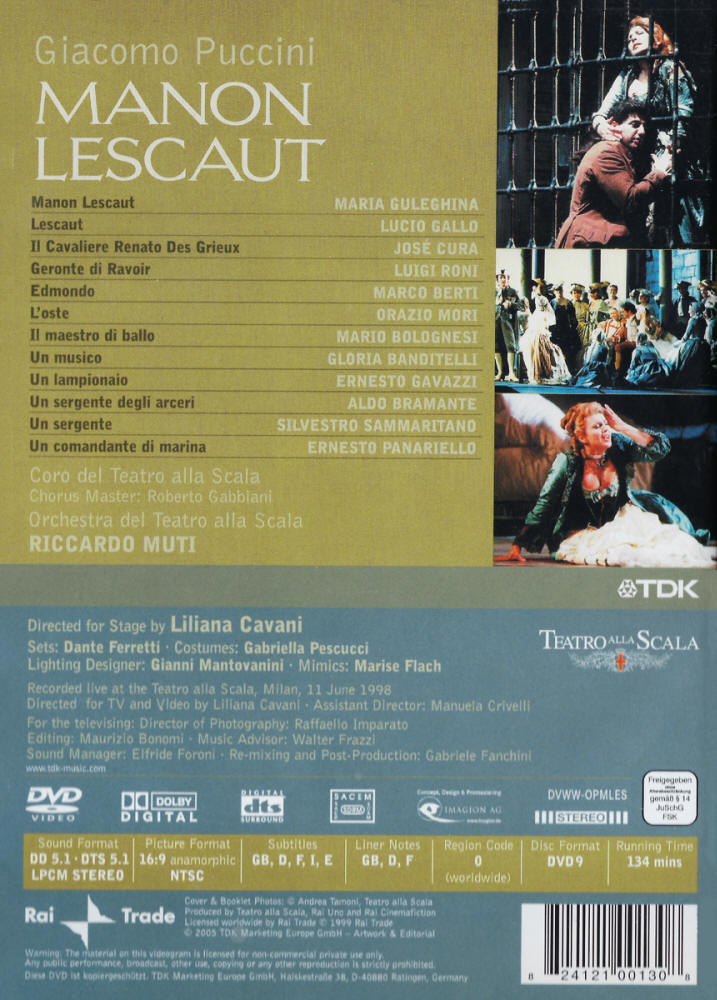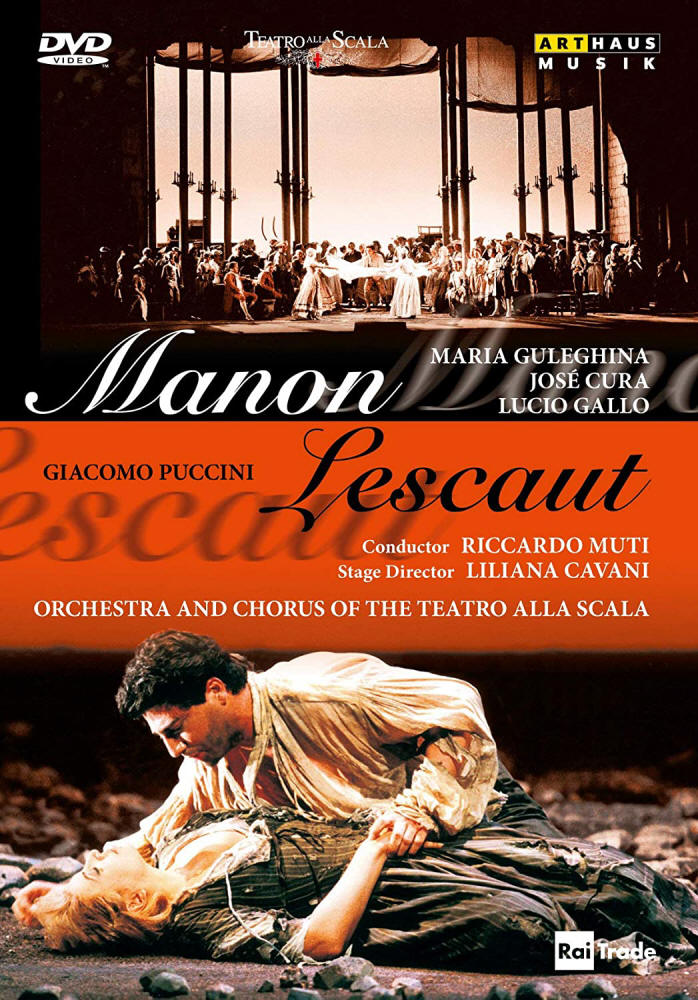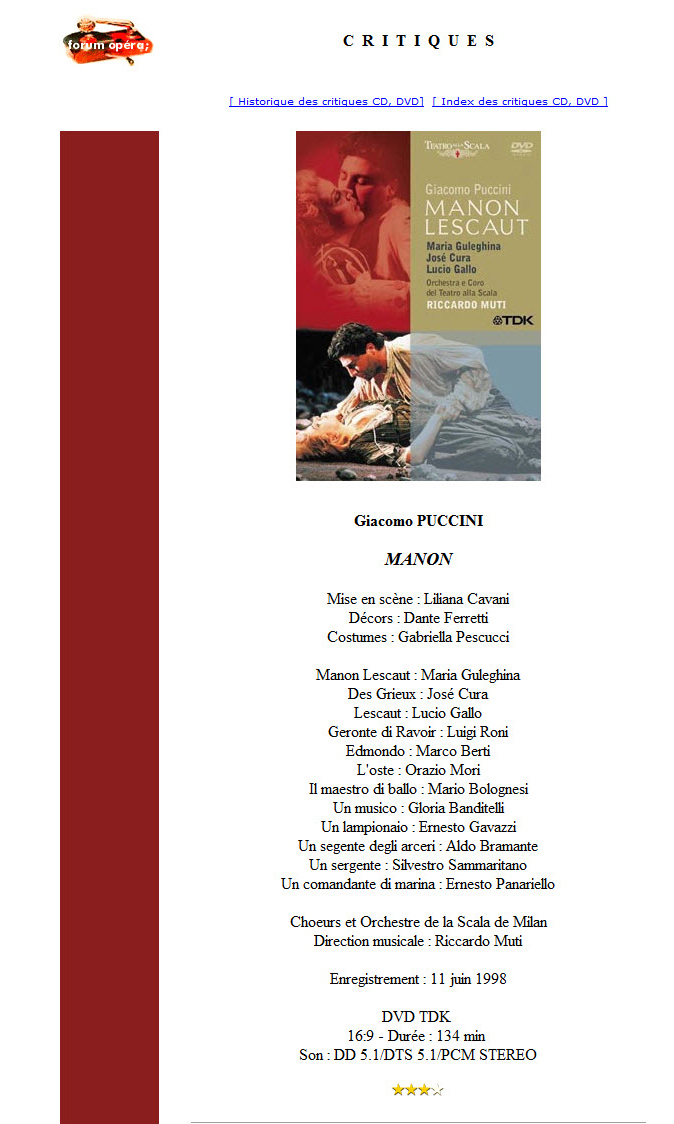|
|
|
||
|
|
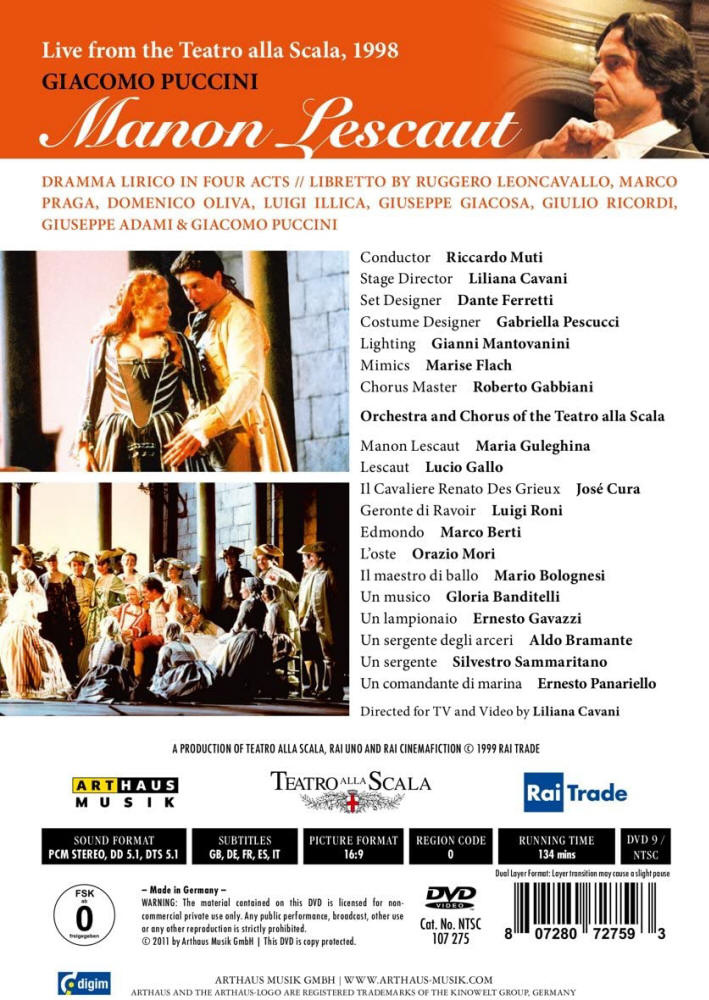 |
||
|
|
|||
|
Manon Lescaut DVD: 'Those interested in seeing [José Cura] in top form need look no further than the Scala video of Puccini’s Manon Lescaut. In addition to an incomparably beautiful reading by Riccardo Muti and the La Scala Orchestra (the last act, tinged with the ashen colors of death, is almost unbearably painful), the video preserves Cura’s remarkable debut as Des Grieux. When asked what made his Manon different from Massenet’s, Puccini indicated that it was the prominence accorded the young chevalier, replying that he had “invested all [his] emotion in the voice of that man, wounded in his heart.” It is precisely this quality of vulnerability, of devastating emotional honesty, that sets Cura’s Des Grieux apart. Though Manon Lescaut has hardly lacked for distinguished tenor protagonists (Pertile, Bjoerling, and Domingo among them), this young man has already made his mark on the role: his soaring cries in Act IV, thrilling though they may be, transcend mere vocal beauty, conveying a desperate, almost animalistic anguish. To be sure, Cura takes some time to warm up, both musically and dramatically, but the overall performance makes one anticipate all the more keenly his forthcoming Erato recital of verismo arias…. American Record Guide Manon Lescaut DVD: 'Guleghina and Cura are visually excellent and manage to convey the emotional aspects of the text dramatically. The production is excellent, thankfully conventional, and the costumes and sets are appropriate. Vocally Guleghina is more of a lyrico spinto rather than the pure lyric that is more appropriate for the role, yet she does manage to lighten the voice when required. Cura is both visually and vocally first rate. The supporting roles are well cast. I am unaware of any competing DVD version of this opera, and—principally because of the excellent visual quality and because the principal singers are fine—I find it is worth investigation by Puccini admirers. Subtitles are available; the sound and picture are both excellent.' Fanfare
Manon Lescaut DVD: 'Poised to inherit the mantle and the juicy operatic roles of the Three Tenors, José Cura has been subject to intense scrutiny. Does he have the vocal goods to match the pretty face and dashing figure? This live recording of Puccini's Manon Lescaut, recorded at La Scala in 1998, offers promising evidence. As the young student Des Grieux, Cura's presence is charismatic from the start, blossoming into a passionate rendition of the famous Act I tenor aria, "Donna non vidi mai." It's been noted that Cura's voice leans toward a darker, almost baritonal range, but while his top notes don't ring out á la Pavarotti, they're resonant enough to convince you that his future as an audience-pleasing heartthrob is both secure and deserved.....' Barnes and Nobles Manon Lescaut DVD: 'This is a high-powered production from La Scala with Riccardo Muti conducting a star-studded cast (Maria Guleghina in the title role, supported by José Cura.) It is predictably excellent. Puccini's libretto is not as logically structured as Massenet's, but it is intensely impassioned, and Muti and his cast find this intensity very much to their taste.' Classical Music Reviews Manon Lescaut DVD: This is a flat-out, heavy-breathing production, directed by Italian film- and-stage diva Liliana Cavani. With Maria Guleghina (Manon) and Jose Cura (des Grieux), she has two fine actors, pretty as movie stars, who pour on the sex. And, yes, they can sing. I had to keep fanning myself. ....Oakland Tribune Manon Lescaut DVD: Maria Guleghina impresses strongly. To my mind she is Puccini’s ideal ‘tart with a heart for gold.’ Just watch her as she taunts Geronte di Ravoir (a far too gentlemanly Luigi Roni) in Act II and the way she disports herself on the floor of the stage to seduce Des Grieux back to her charms. José Cura, as Des Grieux, is in fine voice, colourful and ardent – I just wish he could have been that bit more furious with Manon in his Act II entrance. But his singing with Guleghina (their voices blending so well) ravishes the ear especially in their tempestuous Act II duets and in the intensity of their Act IV duet as Manon dies in the arms of a distraught Des Grieux. Throughout Muti supplies a beautiful, romantic, detailed orchestral backdrop. Avax
Manon Lescaut DVD, Milan, 1998: ‘This Manon Lescaut is a highly polished and dramatic interpretation of the lyrical tragedy performed at La Scala 1998. It features virtuoso performances by Jose Cura (in powerful and dramatically convincing form), Maria Guleghina (who produces some astoundingly sweet soft singing) and Lucio Gallo, and is conducted by Riccardo Muti, who brings out some fine contrasts and balances of tempos, drama and pace.’ Sky Manon Lescaut DVD: ‘Manon Lescaut was last reviewed by [Fanfare] in Jan./Feb. 2006, when this same performance was given a passing note. I would be more enthusiastic, finding Muti an energizing force, while José Cura is devastating as Des Grieux. I am less enthusiastic about Maria Guleghina’s Manon. Once again, a traditional production staged by Liliana Cavani (also responsible for the filming) allows us to appreciate the work in its own right…’ Fanfair Magazine Manon Lescaut DVD: ‘Friends of museum performance practice and historical costume variety will be delighted with the re-release of this DVD from 1998. Director Diana [sic] Cavani (costumes: Gabriella Pesccuci, stage: Dante Ferretti) works in a realistic décor exactly in the ambience given by the composer: the "second half of the 18th century." This alone should be the reason for any opera lover who feels damaged by the modern music theater of our day to buy this disc. More importantly, the singing is excellent and the production showcases one of today's great superstars, José Cura, at the beginning of his career. At the time all of Milan was at his feet. In this respect it is also a historical document. Cura has never sung a part better. [He] sings his donna non vidi mai in a refreshingly beautiful way. With Tu amore ... amore we are sure we have bought the right DVD. There it is, the wonderful piano and the freshness of this young and natural sounding pair of singers, Guleghina & Cura. Cura is not the big screamer but proves to be a pleasant singer who knows how to assess his abilities well and intelligently—if only he would not look up so often... With [No! Pazzo son!] the Puccini fan's heart is opened. This disk is worth the price for the fourth act alone. It is sung divinely in unison, and on the empty, stony stage where no collection of museum junk disturbing the scene. We die with the protagonists in devilishly beautiful Pucchini waves. This is how opera has to be recorded on DVD!’ Musenblätter
|
